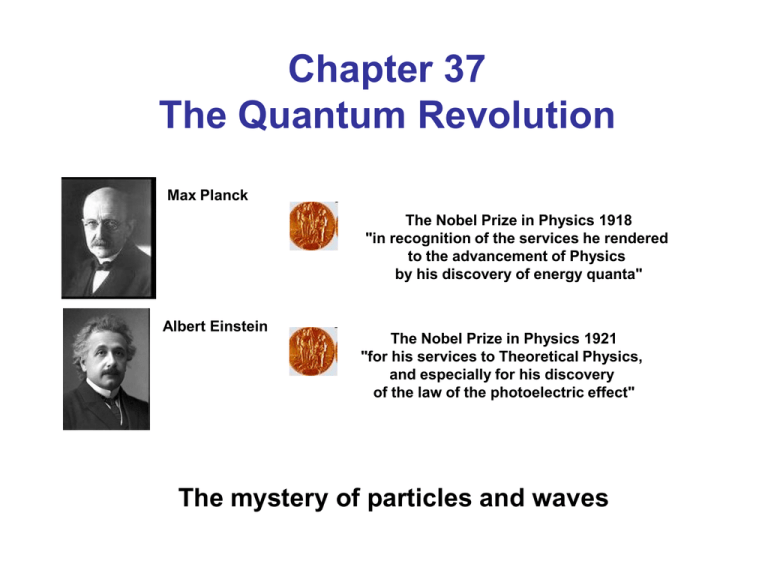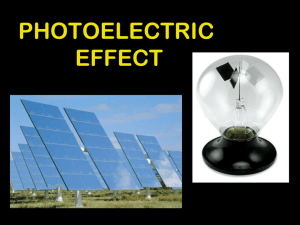Chapter 37 The Quantum Revolution
advertisement

Chapter 37 The Quantum Revolution Max Planck The Nobel Prize in Physics 1918 "in recognition of the services he rendered to the advancement of Physics by his discovery of energy quanta" Albert Einstein The Nobel Prize in Physics 1921 "for his services to Theoretical Physics, and especially for his discovery of the law of the photoelectric effect" The mystery of particles and waves Blackbody Radiation the classical picture The classical radiation field: u f (T ) 8f 2 In a classical statistical theory the average energy per degree of freedom is: k BT To the Rayleigh-Jeans law for a black body emitter u f (T ) 8f 2 c 3 k BT The ultraviolet catastrophe c 3 Extra: On the mode density of the classical radiation field: Counting standing waves Rayleigh’s method for sound waves Allowed wavelengths on a string: l=2L, l=L, l=2L/3, ... Frequencies: f=c/lc/2L, c/L, 3c/2L, 2c/L, ... Allowed frequencies are spaced by c/2L Spectral density is then (in 1 dimension): Number of modes between f and f+Df 2L/c In three dimensions analoguous modes: f ck c k x2 k y2 k z2 2 2 The number of modes between f and f+Df is the volume in k-space in units (/L)3 1 4k 2 Dk 1 L 8Vf 2 Df 2 2 N ( f )Df 2 4 f Df 3 8 c c3 L 4 3 Hence: 3 Specialties (one octant of positive k, 2 polarizations) Radiation mode density in a closed box of Lx Lx L N ( f ) 8f 2 um ( f ) 3 V c (Note, this is irrespective of the energy per mode) Extra: Law of equipartition for a classical radiation field Kinetic energy per degree of freedom 1 2 kin k BT For each sinusoidal oscillation (harmonic oscillator) the potential energy is equal to the kinetic energy 1 2 pot k BT Classical equipartition (for harmonic oscillator) kin pot k BT Note, later: equipartition for quantum states of Bohr atom is different ! Blackbody Radiation toward the Quantum Hypothesis Planck: energy of the oscillating modes come in discrete portions nhf Probability that occurs in the energy distribution of the cavity (Maxwell Boltzmann) p( ) e / kT Mean energy n p n nhfenhf / kT p d n n nhf / kT p n p d e n With: x Define geometrical series: Z ( x) e x nx 1 e x e 2 x 1 1 e x d d Z ( x) x e nx x ne nx dx dx kTx ne nx n e nx n n hf kT kTx d d d Z ( x) kTx ln Z ( x) kTx ln( 1 e x ) Z ( x) dx dx dx kTx e x 1 e x kTx ex 1 hf e hf / kT 1 Planck’s Quantum Hypothesis; Blackbody Radiation Radiation density u f (T ) 8f 2 c3 8hf 3 1 c3 e hf / kT 1 Radiation intensity c 2hf 3 1 I f (T ) u f (T ) 4 c 2 e hf / kT 1 Scaling from frequency to wavelength I l (T ) c l 2 I f (T ) ? 2hc 2 1 l5 e hc / lkT 1 Planck’s Quantum Hypothesis; Blackbody Radiation Planck found the value of his constant by fitting blackbody curves to the formula giving Planck’s proposal was that the energy of an oscillation had to be an integral multiple of hf. This is called the quantization of energy. Derivation of Wien’s law Radiation intensity (Planck) I l (T ) c I (T ) 2 f l 2hc 2 l5 e hc / lkT 1 Define (dimensionless) I l (T ) 2 kT 5 x 5 h 4c 3 For so x hc lkT ex 1 Universal shape: Maximum: 1 g ( x) x5 ex 1 dg x4 x x 5 0 dx e 1 1 e x 1 e x x / 5 xˆ 4.965 hc lmax T xˆk Planck’s Quantum Hypothesis; leading to Wien’s law Blackbody radiation for three different temperatures Note that frequency increases to the left. The relationship between the temperature and peak wavelength is given by Wien’s law: Planck’s Quantum Hypothesis; leading to Stefan-Boltzmann’s law c 2hf 3 1 I f (T ) u f (T ) 4 c 2 e hf / kT 1 Radiation intensity Total intensity 2hf 3 df 0 c2 e hf / kT 1 I (T ) 2h kT x3dx I (T ) 2 x c h 0 e 1 hc x Use again: lkT 4 Then Stefan- Boltzmann With: 2 5k 4 15h3c 2 Check Mathematica (or solve): x 3dx x 0 e 1 I (T ) T 4 5.676 108 W/m 2 K 4 Interpret the Physics of this law ! 4 15 Photon Theory of Light and the Photoelectric Effect Einstein suggested that, given the success of Planck’s theory, light must be emitted in small energy packets: . These tiny packets, or particles, are called photons. Einstein made a step further than the assumptions of Planck who doubted the reality of the quanta Photon Theory of Light and the Photoelectric Effect The photoelectric effect: if light strikes a metal, electrons are emitted. Measurement of kinetic energy of electrons: Stopping potential K max eV0 Measurements at varying f Photon Theory of Light and the Photoelectric Effect The particle theory assumes that an electron absorbs a single photon. Plotting the kinetic energy vs. frequency: hf K W W0 is material property In some cases several kinetic energies measured: Least bound electrons correspond to the work function: W0 Minimum amount of energy required to release electron hf K max W0 Quantum levels K This shows clear agreement with the photon theory, and not with wave theory: No electrons emitted for f < f0 hf W0 Photon Theory of Light and the Photoelectric Effect If light is a wave, theory predicts: 1. Number of electrons and their energy should increase with intensity. 2. Frequency would not matter. If light is particles, theory predicts: • Increasing intensity increases number of electrons but not energy. • Above a minimum energy required to break atomic bond, kinetic energy will increase linearly with frequency. • There is a cutoff frequency below which no electrons will be emitted, regardless of intensity. Conclusion: light consists of particles with energy E=hf : photons Energy, Mass, and Momentum of a Photon Clearly, a photon must travel at the speed of light. Looking at the relativistic equation for momentum, it is clear that this can only happen if its rest mass is zero. p mv / 1 v / c 2 2 E p c m c 2 2 2 2 4 We already know that the energy is hf; we can put this in the relativistic energy-momentum relation and find the momentum: A photon must have directedness (and momentum) as follows from the Compton effect Compton Effect Compton experiments (1923) scattered X-rays from different materials have slightly longer wavelength than the incident ones the wavelength depends on the scattering angle: The Nobel Prize in Physics 1927 "for his discovery of the effect named after him" Arthur Compton Compton Effect This is another effect that is correctly predicted by the photon model and not by the wave model. Before collision hc photon E hf electron Ee mec 2 l p h l After collision hc l' photon E' electron e Etot mec 2 p' h l' pe mev e Ekin 1mec 2 Compton Effect Conservation of energy hc l hc 1mec 2 l' Conservation of momentum h Along x: Along y: Three equations with 3 unknowns, eliminate v and Compton scattering: l' l l 0 h cos mev cos l' h sin mev sin l' h 1 cos mec Compton Effect Dl h 1 cos lC 1 cos mec Note that lC ~ 0.00243 nm So the effects is not so well visible with visible light Compton performed his experiment with x-rays Photon Interactions; Pair Production Photons passing through matter can undergo the following interactions: 1. Photoelectric effect: photon is completely absorbed, electron is ejected. 2. Photon may be totally absorbed by electron, but not have enough energy to eject it; the electron moves into an excited state. 3. The photon can scatter from an atom and lose some energy. 4. The photon can produce an electron–positron pair. Minimum energy: E hc l 2mec 2 Wave Nature of Matter Just as light sometimes behaves like a particle, matter sometimes behaves like a wave. The wavelength of a particle of matter is . De Broglie wavelength of matter Louis De Broglie The Nobel Prize in Physics 1920 "for his discovery of the wave nature of electrons" Wave-Particle Duality; the Principle of Complementarity We have phenomena such as diffraction and interference that show that light is a wave, and phenomena such as the photoelectric effect and the Compton effect that show that it is a particle. Which is it? This question has no answer; we must accept the dual wave–particle nature of light. The principle of complementarity states that both the wave and particle aspects of light are fundamental to its nature. Particles as Waves; Waves as Particles Youngs Interference experiment Particles as Waves "for their experimental discovery of the diffraction of electrons by crystals" George P Thomson Clinton J Davisson 1961 Claus Jönsson of Tübingen Real two-slit experiment with electrons Dubbed: the most famous experiments Richard Feynman on the Double Slit Paradox: Particle or Wave? Wave–particle duality of C60 molecules Markus Arndt, Olaf Nairz, Julian Vos-Andreae, Claudia Keller, Gerbrand van der Zouw and Anton Zeilinger Nature 401, 680-682(14 October 1999) Where is the limit ? Decoherence ?? Electron Microscopes Electrons waves used for imaging Wavelengths of about 0.004 nm. Transmission electron microscope – the electrons are focused by magnetic coils Scanning electron microscope – the electron beam is scanned back and forth across the object to be imaged.





